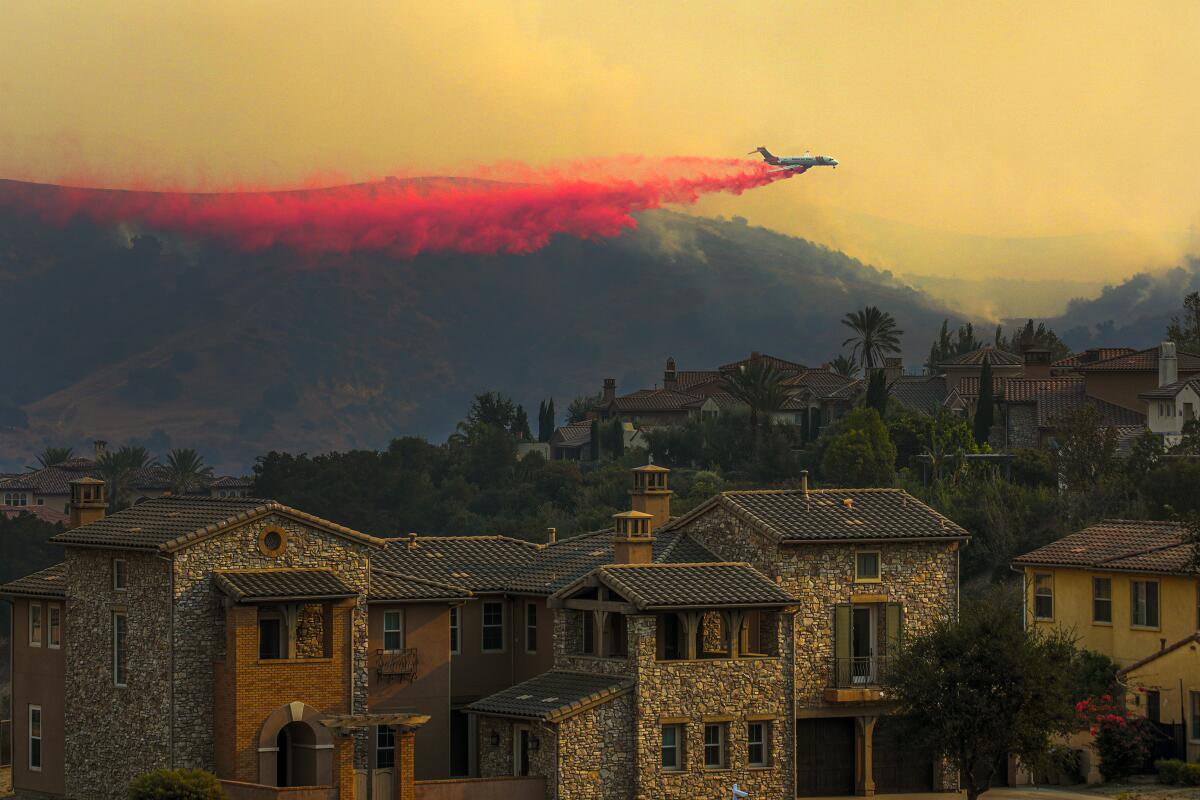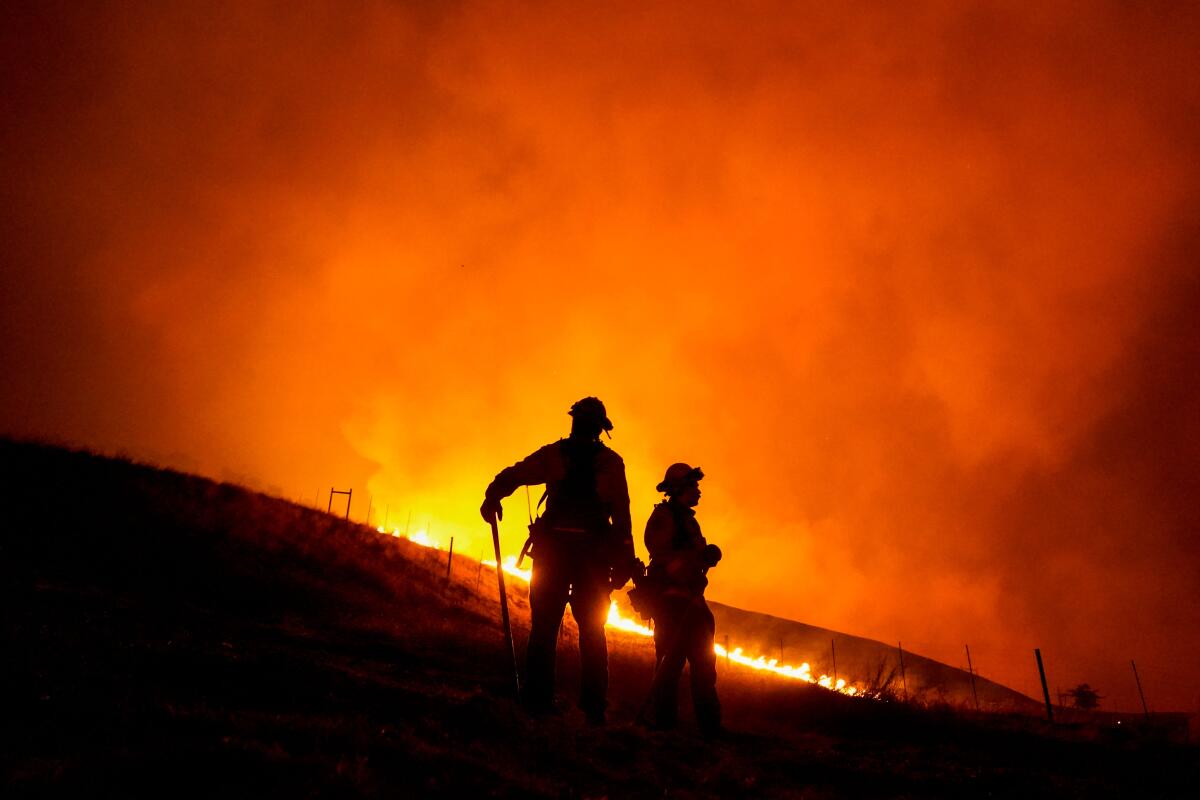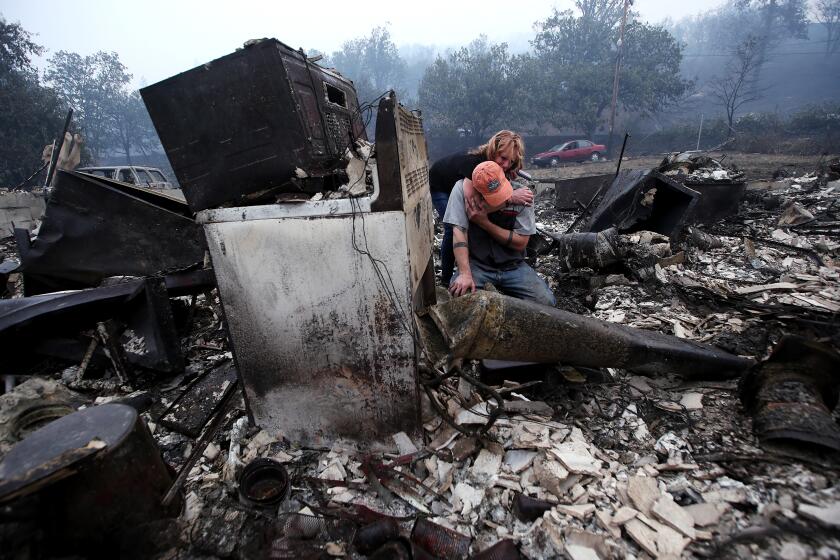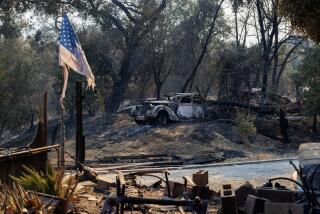Column: Unaffordable homeownerâs insurance is leaving Californians exposed to the elements

SACRAMENTO â Memorial Day weekend means the start of summer vacations â and also the onset of wildfire season. Many Californians will be going ânaked.â
Lots more will be only partially covered, unable to afford so-called wrap-around protection.
Weâre talking about home insurance. Hundreds of thousands of Californians have been abandoned by their property insurers because they live in risky fire-prone areas.
âItâs one of the biggest challenges facing this state right now,â says new state Senate leader Mike McGuire (D-Healdsburg), whose mostly rural district includes North Coast forests and world-class wineries.
In his region, McGuire says, âthe topic of insurance is top-of-mind. You canât go into a coffee shop or grocery store without hearing about it. Thousands and thousands have been non-renewed by insurance companies.â
When a Californian loses fire insurance, there are two basic options: Go without protection and risk losing what for many people is their most valuable asset â known as going naked. Or sign up with a last-resort insurer called the FAIR Plan.
Going naked is practically impossible for mortgage holders because lenders insist on their homes being insured. But itâs tempting for some people whoâve paid off their home, are retired and living on fixed incomes without much spare change.
Major insurers have pulled back from Californiaâs homeowners market, citing wildfires, inflation and other challenges. But there are steps at-risk homeowners can take now to secure coverage and at lower prices.
The FAIR Plan was created by the state in the 1960s after the Watts riots and some natural disasters prompted insurers to bail. Itâs funded by the insurers and has about 375,000 policyholders.
But a FAIR policy is very costly and often covers only fire, not household goods or liability.
âI donât know how fair it is. Itâs so expensive itâs ridiculous,â says Jodi Goodenough, who lost fire insurance for her modern Placer County home in a Sierra forest.
Ironically, her husband, John, owns an insurance agency â and they couldnât get traditional coverage despite their home being fire-hardened with a metal roof and stucco siding. âThey [insurers] donât care,â Jodi says.
Full confession: Sheâs my niece.
In adjacent El Dorado County in the Sierra foothills, then-Placerville Mayor Michael Saragosa lost his home insurance two years ago despite living near two fire hydrants and a fire station.
He got stuck with a FAIR policy that raised his insurance cost by 40%. âI feel lucky,â he says. âI know people paying 100% more. Four out of five City Council members are now on the FAIR Plan.â
Political connections and insider insurance knowledge donât matter.

Former state Insurance Commissioner Steve Poizner, who lives in a wooded area of the Silicon Valley in Santa Clara County, was dropped by his insurer two years ago.
âIâm a former insurance commissioner of California. If it happened to me, it can happen to you,â Poizner wrote in an op-ed for the Los Angeles Times.
Poizner hooked up with an out-of-state carrier. âIt was half the coverage and twice the price,â he told me recently. Eventually he found a willing California insurer.
âBut now theyâve just notified me theyâre not going to renew,â Poizner added. âThis is a broken system.â
It isnât broken just in California. Itâs a nationwide crisis. Climate change is the consensus culprit because itâs blamed for escalating wildfires, flooding, hurricanes, tornadoesâŚ.
The New York Times reported this month that insurers lost money on homeowners coverage in 18 states last year.
âThe result,â it wrote, âis that insurance companies are raising premiums by as much as 50% or more, cutting back on coverage or leaving entire states altogether.â
Denni Ritter, a Western states lobbyist for the American Properties Casualty Insurance Assn., says: âWhatâs unique to California is our regulatory system under Proposition 103. Insurers havenât had the ability to adjust rates to absorb pricesâŚ.
âIn California, for every $1 in premiums, insurers paid out $1.13 in claims between 2012 and 2022. The California situation is untenable.â
Gov. Gavin Newsom is proposing a bill that would require the state Department of Insurance to review rate-hike requests from home insurers within 60 days as companies pull back from the market due to wildfire risks.
Proposition 103 was a citizensâ initiative approved by voters in 1988. It rolled back rates by 20% for home, fire, auto and many types of insurance. And it created an elected insurance commissioner who must approve rate hikes before they can take effect.
But the insurance industry and current Commissioner Ricardo Lara insist it takes too long â up to a year or more â for approvals. Proposition 103 promised 60 days. Lara is aiming for that.
âWeâre clearly operating under 20th century regulations when itâs the 21st century,â Lara says.
Thereâs a lot of finger pointing.
âThe problem is insurance companies are greedy and donât want to insure people without getting as much money from them as they can,â says Jamie Court, president of Consumer Watchdog, which wrote Proposition 103.
âOur plan is to require insurance companies to insure everyone who hardens their home. And it should be reasonably priced.â
Something like that makes sense.
McGuire, whoâs considering a race for insurance commissioner, promises legislation this year to provide incentives for owners to harden their homes â make them more fire-safe. There should be insurer discounts and perhaps government tax credits, he says.
Insurers want to be allowed to project their future liabilities when setting premium rates. Other states permit that. Sounds logical.
And theyâre asking to be reimbursed through premium rates for their cost of insuring themselves against claims resulting from natural disasters.
Lara promises new regulations by yearâs end. That seems too long. He blames the slowness on Proposition 103âs rules.
And Gov. Gavin Newsom is pushing for legislation â at least verbally. Thereâs little action so far.
âWeâve got one more fire season to go through. This will be the last summer of risk before having a stable insurance market,â predicts Sen. Bill Dodd (D-Napa), whose wine country district was devastated by fire and has been active in fire prevention legislation.
âNow we have many cases of people going naked without any insurance. Way more than anybody knows.â
Thereâs no good excuse for them not being offered affordable coverage.
More to Read
Sign up for Essential California
The most important California stories and recommendations in your inbox every morning.
You may occasionally receive promotional content from the Los Angeles Times.









![[20060326 (LA/A20) -- STATING THE CASE: Marchers organized by unions, religious organizations and immigrants rights groups carry signs and chant in downtown L.A. "People are really upset that all the work they do, everything that they give to this nation, is ignored," said Angelica Salas of the Coalition of Humane Immigrant Rights. -- PHOTOGRAPHER: Photographs by Gina Ferazzi The Los Angeles Times] *** [Ferazzi, Gina -- - 109170.ME.0325.rights.12.GMF- Gina Ferazzi/Los Angeles Times - Thousands of protesters march to city hall in downtown Los Angeles Saturday, March 25, 2006. They are protesting against House-passed HR 4437, an anti-immigration bill that opponents say will criminalize millions of immigrant families and anyone who comes into contact with them.]](https://ca-times.brightspotcdn.com/dims4/default/34f403d/2147483647/strip/true/crop/1983x1322+109+0/resize/840x560!/quality/75/?url=https%3A%2F%2Fcalifornia-times-brightspot.s3.amazonaws.com%2Fzbk%2Fdamlat_images%2FLA%2FLA_PHOTO_ARCHIVE%2FSDOCS%2854%29%2Fkx3lslnc.JPG)



